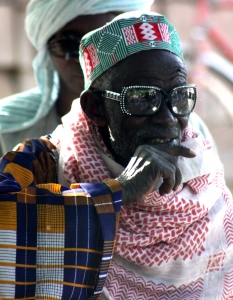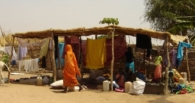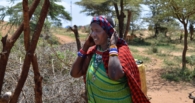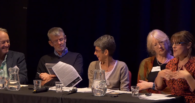Men = the ‘missing’ half of the gender equality equation
‘Being a Man in Nigeria’ – Research Review: Findings and the significance for policy and programming
Lilli Loveday
21 March 2016
/
- 0 Comments

Photo credit: Lilli Loveday
Introduction
Men are often missing from the gender equality equation, yet are integral to ensuring the equation functions, with benefits on both sides. Efforts towards equality tend to be thought of as being ‘about women and girls’, without due consideration for the part men and boys play – both as contributors and as barriers to progress. Policies and programmes often fail to acknowledge or address male perspectives and realities, or concerns about what changes towards gender equality might mean for men in view of ‘expectations’ about their roles and associated behaviour.
Overview of V4C
At an event in London on 18 February, 2016, Voices for Change (V4C) with Social Development Direct (SDD) launched its landmark report, ‘Being a Man in Nigeria’. The report forms a synthesis of four studies – Nigerian Men and Gender Equality Survey (NiMAGES),[1] Media and Masculinity, Conflict and Masculinity and Religion and Masculinity – providing valuable insights into understanding how men can better be part of, and realise the benefits from, gender equality. It sheds light on male perceptions and realities and how they interact with those of women. And, although findings are specific to the Nigerian context, the emerging recommendations and lessons are relevant to wider programming and policy efforts, making them of interest to stakeholders across sectors.
The V4C programme – funded by DFID and being implemented over four years (2013-17) by a range of partner organisations – aims to empower women and girls in Nigeria. V4C takes an integrated approach which seeks to build on the power of voices to promote positive social norm change, developing and utilising ‘norm marketing’ strategies to encourage a generation to ‘speak up and speak out’.
V4C: Being a Man research
The thinking behind ‘Being a Man in Nigeria’ arose from conversations about why gender equality efforts were not making progress. According to the Research Lead, Patience Ekeoba: ‘men, men, men – they kept reappearing…men were holding the power’. The research objectives were to understand: (i) what perceptions and stereotypes exist; (ii) why power relations are unequal; (iii) the role of conflict, media and religion; and (iv) the opportunities for and the barriers to progress.
Presenting the findings
Findings highlight a disconnect between perceptions and reality, with men’s and women’s actual roles often in contradiction to those expected of them. This has led to both positive and negative experiences and provides evidence of how efforts toward equality can better be achieved.
The perceptions….
Dominant views of masculinity and expectations of what it means to be a man were centred around men being tough, strong, fearless, responsible, in control; men are expected to be the breadwinner, the provider, ‘a kind of Super-man, able to fly’. Femininity and being a woman involved notions of being tolerant, patient, deferential, responsive to husbands; women were considered weak, led by their emotions, vulnerable, with a role primarily in caring for the family/the household. Conversely, a man who is unable to provide/does not earn an income, or a woman who is unmarried or divorced, is considered ‘useless’, or not deserving of respect. There was a strong perception that women should obey their husbands, with an overwhelming majority (9 out of 10 men and 8 out of 10 women) indicating that men should be the final decision-makers. There were significant levels of tolerance of violence against women, with 71% of women and 66% of men believing that women should ‘put up with’ violence to keep the family together.
‘Eagle was born to fly high to the peak of the sky. The chicken, no matter how you train it, will never fly high to the stage of eagle…’
Man speaking about the differences between men and women
‘All I think differentiates a man from a
woman is physical differences because women are equally up to the task; they can make decisions.’
Male student on the differences between men and women
The prevailing views were also challenged by and existed alongside more ‘equitable’ perceptions. Male ‘toughness’ and dominance were not considered ‘necessary’ by 5 out of 10 women and 3 out of 10 men, and there were ‘alternative’ notions of masculinity and femininity: men as peaceful, loyal, caring; women as advisors, mature, responsible. There was also evidence of other shifts and a rejection of absolute control over women by men, with the majority considering female genital cutting to be ‘bad for us’, and rejecting wife inheritance as well as the idea that bride price entitled men to do exactly what they wanted. There was some acknowledgement that women could provide support to men and should be consulted, with increasing recognition that their contributions could ease the household burden. And this existed alongside widespread belief that men contributing to the household was an indication of their love and support (77% of women and 79% of men). But there were also contradictions, reflecting the complexities and challenges in terms of making progress towards greater gender equality. For example, women and men were considered by 7 out of 10 respondents (both male and female) to make good leaders, and for it to be ‘right’ for them to aspire to top positions of authority, yet almost the same proportion (6 out of 10) agreed that women should ‘not get involved in politics’.
…vs the realities…
Indeed, lived realities often clashed with or went against persistent social perceptions about what men and women should be doing – both positively and negatively. ‘Expected’ roles and standards were often difficult to attain in contexts of significant insecurity (both financial and conflict-related), wider inequality and poverty, and changing gender relations.
Women were becoming more active in the labour market (often out of necessity, in the absence of a male ‘earner’, or to supplement income), more visible in public life, and better educated and more vocal. 40% of women were employed formally or informally, and couples increasingly reported joint decision-making on issues related to family planning (6/10 men, 7/10 women) and finances/large investments (2/10 men/women). Men, especially from younger generations and with more education, were increasingly doing household work.
‘To be a man is to overcome challenges – does this mean I’m not a proper man?’
Quote by a man regarding his ‘reality’
At the same time, there was criticism that men were not living up to their expected roles, with conflict and uncertain economic and political contexts leading many men to struggle and with their positions ‘undermined’. Women were also reported to behave ‘less modestly’ and to be engaging more in aggressive, violent behaviour (including out of revenge), whilst being at the same time the most vulnerable to conflict and violence because of their ‘care-giving role’. Men often reported being unemployed, without any form of income, and experiencing frustration over a lack of authority. Struggling to fulfil the expected ‘family provider’ role, men spoke of feeling ‘out of their life’, and reported physical and mental health problems, including depression, low self-esteem and addiction, and there were increasing reports of men engaging in violent behaviour. Male involvement in the domestic sphere led to criticism of men as being weak, ‘charmed’ or ‘woman-wrappers’ (i.e. under the control of their wives). In areas of conflict, men who stayed at home and didn’t protect their women and families were thought of as ‘weak’, ‘acting like women’.
Endeavouring to live up to society’s perceptions and prove their dominance, men sought to assert themselves as ‘real men’ (and ‘not women’) in other ways. In order to receive greater community respect and a sense of value, men were incentivised to join vigilante groups. Furthermore, large numbers of men committed violence against their partners – 42% of women had experienced some form of domestic violence, and 40% of men reported perpetrating violence against women.
Influencing factors: positive and negative
Religion, conflict and the media were strong influencing factors, alongside ‘role models’ in community and household environments. Whilst often these factors reinforced negative and gender inequitable perceptions, they were also cited as being potential sources of positive imaging and promotion of greater equality.
Perceptions of ‘appropriate’ masculine and feminine roles were justified by religion, with nature and the ‘divine order’ seen to have bestowed complementary roles upon men (the ‘head’) and women (the ‘heart’). At the same time, religion was not seen to be a limiting factor for women speaking out, nor as forbidding women from holding resource rights, and religious leaders promoting gender equity were generally respected. Conflict often undermined perceived roles and had negative effects on the lived realities of women and men and their interactions, especially in contexts of insecurity. And the media often reinforced – or did little to challenge – unequal perceptions, both under-representing women in decision-making roles and making violence (including violence against women) seem acceptable, even ‘attractive’. Yet, whilst media outlets reported a two-way barrier to promoting alternative behaviours given wider sexism in the industry and across society, there were indications that negative stereotypes were condemned through the media, on occasions to some effect. Home and school environments were important influencers on male/female identities. Whilst the persistent undervaluing of girls’ vs boys’ education and exposure to corporal punishment in schools had a negative effect, positive equitable attitudes were influenced by (i) the presence of role models (boys were more likely to engage in ‘non-typical’ roles if they had observed a father doing the same); (ii) a secure home free from violence (with those who had not witnessed violence less likely to be perpetrators); and (iii) access to education (promoting girls’ equality, and evidence that educated men were less likely to endorse inequitable divisions).
Ways forward: responses and implications for policy and programming
The research has been widely received in Nigeria and globally, with a number of ‘high profile’ (including notable male) figures endorsing its publication and its findings. It has been used to ‘start conversations’ and dialogue, with responses from ‘Men’s Chats’ (organised to further explore the implications of the research for ways forward) highlighting that men considered the research to be a ‘liberating tool’. They indicated that they not only ‘saw themselves’ in the report, but that they were also keen for the negative perceptions of men – and harmful (for both men and women) gendered societal expectations – to be challenged, with new norms adopted and efforts made to change thinking.
In relation to policy and programming, the research highlights a number of important findings, notably that:
- although unequal gender perceptions largely persisted, they were being contested and there were some indications of progress and change;
- there was a ‘mismatch’ between perceived and lived masculinities and femininities, which – in the absence of positive alternatives – reinforced gender inequities and negatively impacted on male and female realities;
- the wider context (including religion, media and role models) was significant and influential, but often perpetuated rather than challenged stereotypes.
Policies and programmes should better engage men in processes, recognising that they are both contributors and barriers to gender equality. Furthermore, recognising the potential for change to be influenced, policies and programmes should better utilise media outlets, religious leaders, and the promotion of ‘role models’ (male and female) to encourage change in positive directions (e.g. through media publicity, in schools etc.). These efforts should build on already existing and positive perceptions, so that they resonate and ‘make sense’. Young people, socially mobile, and media savvy, could especially be encouraged to engage in the discussion, an approach that V4C is adopting through its embedded ‘social marketing’ strategy.
Importantly, the promotion of gender equality means understanding the potential incentives for change in particular contexts and engagement of men alongside women in considering the benefits of more equitable relations, so that equality is not thought of as being about either side ‘losing something’ (e.g. for men, power/control/status) but about gaining something more beneficial (e.g. shared responsibility/greater security/better well-being). As expressed by Caroline Eyne (V4C team leader), this means ‘pressing the right buttons’: ‘whatever [the buttons are] we’ll use to promote change’. But, doing this, and avoiding promoting identities which are at odds with one another and unachievable, requires promoting alternative, more equitable masculinities alongside promoting alternative femininities. However, if men are engaged fully, they will contribute to defining ‘new’ standards and ‘buy into’ and be part of determining and enabling alternative ways forward. The V4C research provides valuable insights into how this might be achieved, with the programme also providing an opportunity to learn how processes of change can be better facilitated.
[1]NiMAGES is a qualitative and quantitative tool designed to explore, through individual in-depth surveys, ideas about masculinity/femininity, gender equality, women in leadership and decision-making positions, as well as about violence against women and girls in six states across Nigeria.
You must be logged in to post a comment.



